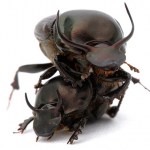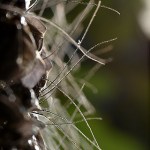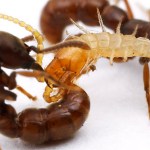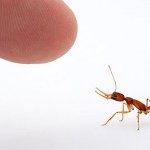Photography
tags: Gray Jay, Perisoreus canadensis, birds, mystery bird, bird ID quiz
[Mystery bird] Gray Jay, Perisoreus canadensis, photographed in Yellowstone National Park, Wyoming. [I will identify this bird for you tomorrow]
Image: Terry Sohl, 9 August 2007 [larger view].
Photo taken with a Canon 20D, 400 5.6L.
Please name at least one field mark that supports your identification.
Review all mystery birds to date.
A fishing cat (Prionailurus viverrinus), photographed at the National Zoo.
...these would be the beetles of choice.
Onthophagus taurus dung beetles,
showing size and horn variation among males.
Dung beetles in the widespread genus Onthophagus sport a bewildering array of horns. Not only do the horns of different species vary in shape, size, and the body part from which they grow, many species show a marked dimorphism within the males.
Consider these two male morphs of O. nigriventris, an African species:
The big guy on the right is a major male, and he does pretty much what you'd expect. He bullies his way around with shows of bravado, guarding his burrows…
tags: Muscovy Duckling, Cairina moschata, birds, mystery bird, bird ID quiz
[Mystery birds] Muscovy Duckling, Cairina moschata, photographed in Hermann Park, Texas. [I will identify this bird for you tomorrow]
Image: Joseph Kennedy, 22 March 2009 [larger view].
Nikon D200, Kowa 883 telescope with tsn-pz camera eyepiece 1/320s f/8.0 at 1000.0mm iso400.
Please name at least one field mark that supports your identification.
The single eyeline is seen only in a small subgroup of the dabbling ducks; the mallards, black ducks and their close relatives. However, a close look at the thicker…
tags: NYC, Upper West Side, Manhattan, flowers, nature, image of the day
Tulip Blossom, UWS, Manhattan, NYC.
Image: GrrlScientist, 10 April 2009 [larger view].
tags: Chestnut-backed Chickadee, Poecile rufescens, birds, mystery bird, bird ID quiz
[Mystery bird] Chestnut-backed Chickadee, Poecile rufescens, Photographed near a small Olympic Peninsula lake in Shelton, Washington State. [I will identify this bird for you tomorrow]
Image: Lee Rentz, 19 February 2009.
Please name at least one field mark that supports your identification.
Review all mystery birds to date.
A herd of bark lice (Psocoptera: Cerastipsocus sp.) grazes lichen across a tree trunk near Córdoba, Argentina. Here's what one of the adorable little beasties looks like up close:
Technical details:
Lens: Canon MP-E 1-5x macro lens, at about 1x (top photo) and 4x (bottom photo).
Body: Canon EOS 20D
Flash: Canon MT-24EX twin-flash, diffused through tracing paper (bottom photo), or held behind tree to backlight the psocids (top photo).
Settings: ISO 100, f/13, 1/250 sec.
I never met Carl Rettenmeyer.
I regret this.  Rettenmeyer forms a part of my heritage as an ant photographer.  As a kid, my first exposure to army ants came through Rettenmeyer's stunning imagery in Ranger Rick magazine. His photos adorn the pages of E. O. Wilson's 1971 classic The Insect Societies as well as the later tome The Ants.  Before I ever picked up a camera, or even considered myrmecology as a career, Rettenmeyer's ants were well seared into my memory.  They still simmer there, forming a mental backdrop for thoughts of army…
tags: Lost, nature, Helsinki, Finland, image of the day
This is the view from the view from the bus stop
where I became temporarily lost, outside Helsinki, Finland.
Image: GrrlScientist, 6 March 2009 [larger view].
An Amblyopone oregonensis huntress delivers a paralyzing dose of venom to a centipede. This lets the ant larvae consume it alive later, at their leisure. Ow. Ow, Ow. Yes, that is the stinger you see, sunk deep into the head.
A cricket is impaled on the mandibles of a Malagasy trap-jaw ant, Odontomachus coquereli. That's gotta hurt.
Mantids don't wait for their prey to expire before they tear them to pieces.
An aphid receives the egg of a braconid wasp (Aphidius ervi).
But that's probably better than getting your innards suddenly schlorped out by a syrphid fly larva.
tags: American Coot, Fulica americana, birds, mystery bird, bird ID quiz
[Mystery bird] American Coot, Fulica americana, photographed in [I will identify this bird for you tomorrow]
Image: Joseph Kennedy, 2 April 2008 [larger view].
Nikon D200, Kowa 883 telescope TSN-PZ camera eyepiece 1/800s f/8.0 at 1000.0mm iso400.
Please name at least one field mark that supports your identification.
Rick Wright, author of Aimophila Adventures and Managing Director of WINGS Birding Tours Worldwide, writes:
Lobed feet are rare in birds. The foot in question is too long, too green, and too strong for…
A sloth bear (Melursus ursinus), photographed at the National Zoo.
tags: shadow and light, nature, Helsinki, Finland, image of the day
Shadows and Light
on the brick walkway in downtown Helsinki, Finland.
Image: GrrlScientist, 28 February 2009 [larger view].
If you enjoy bioephemera, you should take a moment to check out Scienceblogs' new blog, Photo Synthesis:
While doing our usual browsing of the blogosphere, we've become aware of the vast number of excellent blogs featuring science imagery, from neural networks captured with a light microscope to images of supernovae billions of light-years away. To take advantage of this wealth of visual content, we've decided to host our favorites here on ScienceBlogs, with a rotating line-up of photobloggers we'll select monthly.
This month, Alex Wild of myrmecos kicks things off with his insect…
tags: mystery bird, identify this bird, birds, mystery bird, bird ID quiz
[Mystery bird] Scarlet Tanager, Piranga olivacea, photographed in Newton Hills State Park in South Dakota. [I will identify this bird for you tomorrow]
Image: Terry Sohl, 16 May 2007 [larger view].
Photo taken with a Canon 20D, 400 5.6L.
Please name at least one field mark that supports your identification.
Rick Wright, author of Aimophila Adventures and Managing Director of WINGS Birding Tours Worldwide, writes:
Blur your eyes a little and step back from the monitor: what do you see? I see a smallish bird but not…
Rokan the Sumatran tiger (Panthera tigris sumatrae). photographed at the National Zoo.
Aedes triseriatus, Eastern Treehole Mosquito (Larva)
I have a symbiotic relationship with other scientists. They let me in on their cutting-edge studies, giving me and my camera unfettered access to their charismatic little subjects. When the research is published and the science press picks up the breaking story my photos go along for the ride, sometimes garnering license fees. If the story is big enough, the photos are also positioned for the textbook market. In return, the researchers get photos that help them promote their work in talks and on laboratory web pages.
On Monday I…
tags: restaurant, nature, Helsinki, Finland, image of the day
This ship is actually a restaurant in downtown Helsinki, Finland.
Image: GrrlScientist, 28 February 2009 [larger view].




